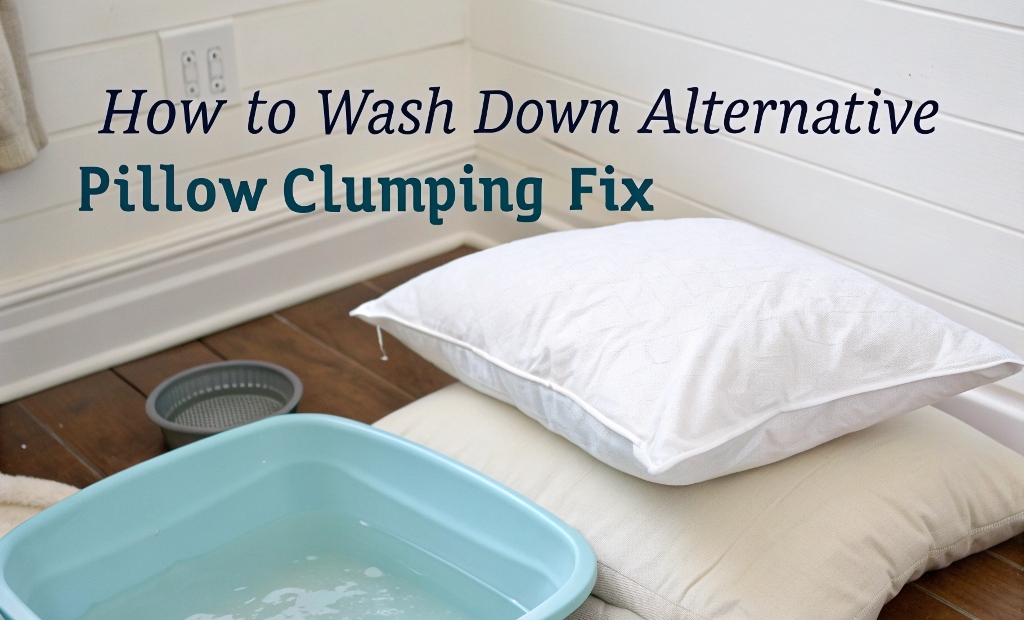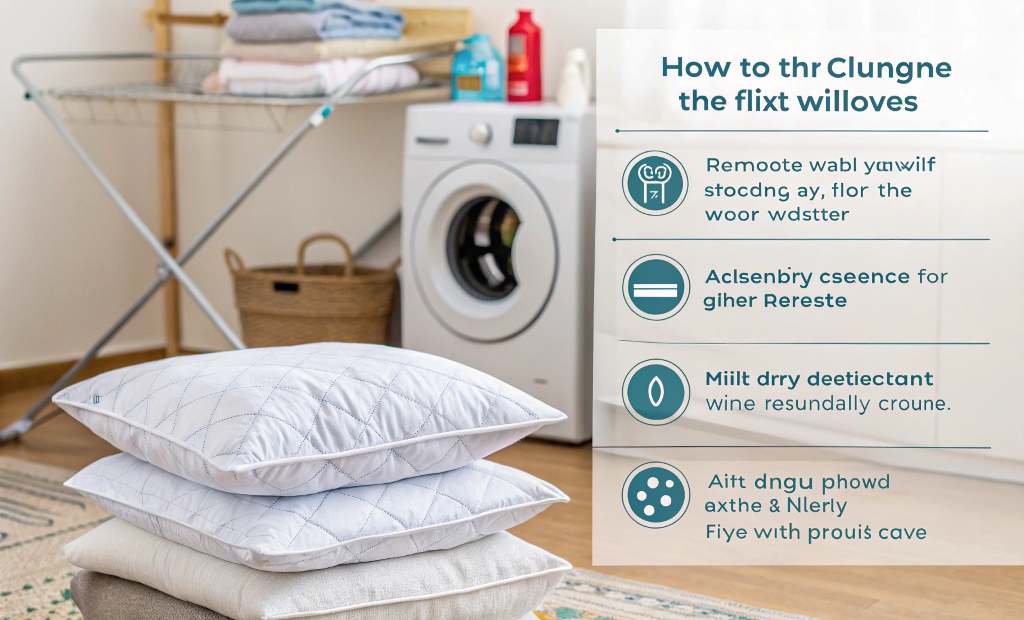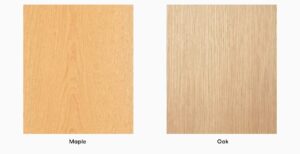How to Wash Down Alternative Pillow Clumping Fix: Easy Steps to Keep Your Pillows Fluffy and Fresh

Washing down alternative pillows can feel tricky—especially when they come out clumpy and uneven. If you’ve ever pulled your favorite pillow from the dryer and found it lumpy, you’re not alone. Fortunately, there’s an easy fix. Down alternative pillows are made to mimic real down, but they need special care to avoid clumps.
In this guide, we’ll walk you through how to fix clumping, properly wash your pillows, and even share tips to keep them fresh longer. You’ll also learn what causes that soggy lump in the first place and how to prevent it next time. We’ve personally tested these steps, and they work. One time, I ruined a $60 pillow by washing it wrong. Since then, I’ve found a much better way—and I want to help you avoid the same mistake. For more expert tips on caring for your pillow collection, explore Pillow Show Case and discover everything from maintenance to pillow types.
The Common Problem: Why Down Alternative Pillows Clump After Washing

Clumping is often caused by trapped moisture or uneven washing. It’s frustrating—but preventable.
Down alternative pillows use synthetic polyester fibers that mimic the softness of real down. When washed improperly, those fibers clump together, creating hard lumps. According to the National Sleep Foundation, the average pillow should be washed every 4–6 months to remove dead skin, sweat, and allergens. But poor washing technique causes more harm than good.
Interestingly, many people also complain that new pillows smell bad after washing. That’s because leftover detergent or mildew builds up inside the filling. So clumping and odor often go hand in hand.
Here’s what happens when you wash incorrectly:
- Washing in hot water melts or warps the fill.
- Skipping a second rinse leaves detergent behind.
- Overloading the machine causes uneven agitation.
Each of these mistakes breaks down the structure of the pillow, causing the stuffing to ball up.
Step-by-Step Guide: How to Wash Down Alternative Pillows Without Clumping
Washing the right way makes all the difference. Here’s how to do it step-by-step.
1. Check the Label First
Always read the care tag. Some pillows allow for machine washing; others require spot cleaning. Most down alternatives are safe to wash, but each brand varies.
2. Use a Front-Loading Washer
Top-loading machines with agitators can be too rough. Use a front-loader if possible. It gives a gentler clean and prevents twisting.
3. Wash Two Pillows at a Time
This keeps the machine balanced and reduces wear. Wash in cold or warm water on a gentle cycle.
4. Use a Mild, Liquid Detergent
Avoid bleach and fabric softeners. They damage synthetic fibers. Stick to a small amount of liquid detergent.
5. Extra Rinse is Crucial
Do a second rinse cycle. This removes any detergent left inside, which could cause clumping or odor.
The Dryer Secret: How to Restore Pillow Fluffiness After Washing
The dryer is where many people go wrong. Drying properly is the real trick to fixing clumping.
1. Dry on Low Heat or Air Fluff
High heat melts synthetic fibers. Use low or air-only settings for longer but safer drying.
2. Use Dryer Balls or Clean Tennis Balls
Toss in two to three dryer balls or tennis balls. They bounce around during drying, breaking up clumps and restoring shape.
3. Pause and Fluff by Hand
Halfway through the cycle, pause the dryer and manually fluff the pillow. Pull the clumps apart and shake out the filling.
4. Dry Thoroughly
This part takes time. A damp pillow will clump again. Dry until there’s no moisture left inside. You can check by squeezing the middle—if it feels cool, it’s not done.
According to Good Housekeeping Institute, drying may take 2–3 full cycles. Patience is worth it for long-term comfort.
Fixing Already Clumped Pillows: What to Do If It’s Too Late
Don’t toss your pillow just yet—clumps can be fixed even after they form.
Manual Fluffing Techniques
- Lay your pillow flat on a table.
- Press down firmly, then lift and shake.
- Use your fingers to pull clumps apart.
Steam the Pillow
Use a handheld steamer. The steam relaxes the fibers and helps you reshape them more easily.
Massage It Daily
Set aside five minutes a day for manual fluffing. Over time, the pillow will regain its shape.
From personal experience, I once thought a clumpy pillow was beyond saving. But after a few fluff-and-steam sessions, it felt almost new. It’s worth the effort.
Preventing Clumping in the Future: Daily and Weekly Tips
Prevention is easier than repair. Here’s how to keep your pillows clump-free.
Daily Care Tips
- Fluff your pillow each morning.
- Rotate the pillow to avoid wear on one side.
- Keep it in a breathable pillowcase.
Weekly Habits
- Air out the pillow in sunlight once a week.
- Spot clean stains before they set.
- Keep it dry—avoid sleeping with wet hair.
Use Pillow Protectors
According to a study by the American Academy of Allergy, Asthma & Immunology, pillow protectors reduce exposure to dust mites and allergens by up to 50%. Less moisture and dirt means less clumping.
Make these habits part of your routine. It takes just a few minutes but makes a huge difference.
When to Replace Your Down Alternative Pillow
Even with great care, pillows have a shelf life.
Signs It’s Time to Replace:
- It stays flat no matter how much you fluff.
- It smells musty even after washing.
- You wake up with neck pain or headaches.
- You see visible clumps that don’t break apart.
The Sleep Foundation recommends replacing pillows every 1–2 years, depending on usage. Keeping track helps protect your neck and sleep quality.
Caring for your down alternative pillow doesn’t have to be hard. With a few changes in how you wash and dry, you can say goodbye to clumps for good.
Now that you know how to fix and prevent clumping, go check your pillows. Are they in good shape? If not, follow these tips and bring them back to life. Was this guide helpful? Leave a comment below or share with someone who’s battling pillow lumps!
Read More Also: The Hidden Link Between Pillow Firmness and Shoulder Impingement in Side Sleepers
FAQs
What is the best way to wash a down alternative pillow?
Use a front-loading washer, cold water, and a gentle cycle. Wash two pillows at once and rinse twice.
How do you fix a lumpy pillow after washing?
Tumble dry with dryer balls, fluff by hand during drying, and let it fully dry before use.
Can clumping be prevented?
Yes. Use pillow protectors, fluff daily, wash with care, and avoid high heat during drying.
How long do down alternative pillows last?
Typically 1–2 years. Replace when they stay flat or smell bad even after cleaning.
Why do pillows smell bad after washing?
Leftover detergent or moisture inside can cause odors. Always rinse twice and dry completely.








